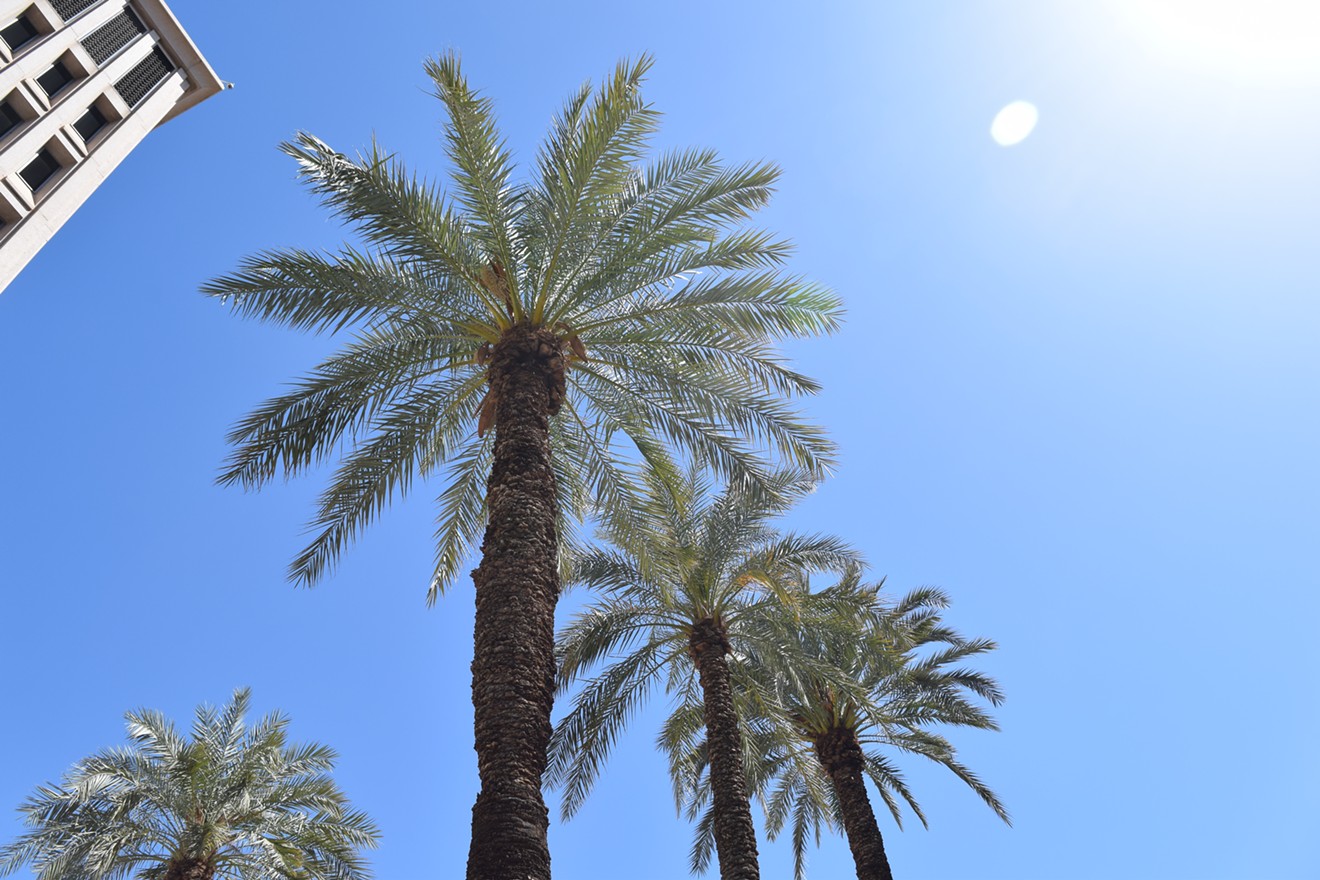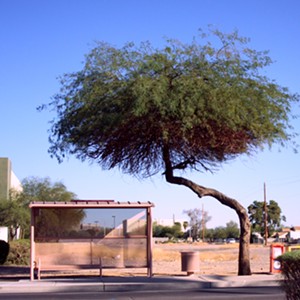Phoenix is hot. Trees can help a city cool down. So, the Phoenix City Council says it wants to plant more trees.
But the city has let its plans for an urban shade canopy wither, according to a volunteer committee of urban-planning wonks, architects, and arborists.
Although Phoenix adopted an ambitious tree master plan in 2010, the citizen-led Tree and Shade Committee says that Phoenix is not moving quickly enough to incorporate shade cover and trees to a brutal urban landscape that is only going to get hotter due to climate change.
"This beautiful plan was put together by people within the city," said arborist and tree committee member Kasey Billingsley. "Nothing has happened since."
The Tree and Shade committee formed last November after tree advocates watched eight trees get ripped out of a shade-covered downtown plaza. Now, they're trying to give Phoenix's policies teeth despite encountering resistance from city staff. At a City Council meeting on Wednesday, tree advocates used a citizen petition to force a response from the city and to ask council members to move faster on their long-awaited shade goals.
The Council largely sidestepped their requests.
Tree and Shade Committee members argue that in Phoenix, hundreds of trees to die or get uprooted every year. The city has about 92,000 trees, but by some estimates, at least 1,000 of those trees are lost every year due to storm damage, poor maintenance, and vehicle collisions.
To be sure, the city plants new trees every year, including around 2,000 trees in 2017. But committee members say that Phoenix’s plan to cover 25 percent of the city by 2030 — which advocates hope will reduce temperatures and make the city more walkable — have languished. Some neighborhoods of the city are covered with 14 to 18 percent shade canopy overhead. In other areas, like the Central City Village, which encompasses Phoenix's downtown core, shade canopy is as low as 6.1 percent. Lower-income and under-served communities tend to have less shade canopy.
To the dismay of volunteer committee members, Phoenix still has not created a formal Tree and Shade Committee to oversee the urban forest as required by the tree master plan, which the City Council passed eight year ago.
The Council used to have an Urban Forest Infrastructure Team during the early stages of the tree master plan, and city staff claim that this group accomplished many of its goals. The advocates want more.
Average temperatures and the frequency of heat waves in Phoenix have increased in recent decades. Plus, the urban heat island effect is worse in areas where trees are absent as heat radiates off the pavement at night.
In an email, Phoenix Planning and Development Director Alan Stephenson defended the progress on trees and listed the city's recent accomplishments, such as partnering with utility companies Salt River Project and Arizona Public Service to replace trees that grow into power lines and have to be removed, and incorporating "green infrastructure" into projects like Taylor Mall and Civic Space Park.
"I know that some stakeholders are frustrated that more has not happened, but there are many diverse stakeholders that are concerned about not having enough police officers and other issues that affect their daily lives," Stephenson wrote.
Not content, the citizen Tree and Shade Committee drafted more aggressive ordinance guidelines on trees that includes recommended tree-planting practices, removal procedures, language on ordinance violations, and a fine structure that ranges from $250 to $25,000 for every day that a violation continues.
The committee is also hoping to maintain a diverse selection of tree species that fit with the character and topography of the individual neighborhoods. Billingsley said that they want to avoid planting trees which require a great deal of water and which are less heat-tolerant, such as ash and pine trees. "We can’t expect to have these large shade trees that say, Savannah, Georgia, has," Billingsley said.
On Wednesday, City Council members adopted a version of what city staff proposed instead — more of an emphasis on planting new trees and adjusting zoning ordinances, less of a proactive enforcement regime. And instead of creating a muscular, formalized version of the Citizen Tree and Shade committee, the council banished tree oversight powers to a new subcommittee that will be under the purview of the existing Environmental Quality and Sustainability commission.
Deputy City Manager Karen Peters told the council that city staff progressively increased their tree-planting goals. Between the street transportation and parks departments, Phoenix is on track to plant 3,000 this year, she said. If it looks like the ambitious Tree and Shade Master Plan was neglected, it was because financial constraints after the recession prevented the city from investing in new trees. In recent years, Phoenix has struggled to beat back budget shortfalls, but this year the city projects it will have a small surplus.
"For a number of years after the master plan was adopted, we were not in the budgetary position to replace them," Peters said.
According to citizen committee members, making significant progress on tree canopy goals requires all-encompassing enforcement.
Mimicking cities like Austin, Texas, which has robust tree-protection rules, the Tree and Shade Committee wanted to ensure that even private property owners replace trees and maintain them for long-term viability. To do so, they recommended that Phoenix's tree ordinances be given teeth: fines, enforcement, and everything that goes with enhanced government regulation.
Nicole Rodriguez, another arborist on the citizen Tree and Shade Committee, said, “It’s not that people will never be allowed to remove trees. It’s just like with any property-permitting process, the city will be accountable for making sure that the property owner is being responsible.”
For instance, the committee examined tree policies elsewhere that stipulate if a property owner wants to remove trees, the city will develop a plan with them to offset the loss to the canopy, Rodriguez said. The goal, she said, is not to create a punitive or onerous tree ordinance, but to push the city to accomplish its shade goals in a sustainable and efficient way.
“It’s not saying, ‘No, you can’t.’ It’s just making it go through a process where there’s accountability,” Rodriguez said.
People who don't comply could be "subject to civil actions and administrative penalties as determined by the City Attorney," according to the language of the committee's ordinance guidelines.
At its meeting on Wednesday, the city council took a small step toward expanding tree regulations with a recommendation that city staff draft new ordinances with strengthened requirements for trees and shade. But these ordinances will apply to public, commercial, and industrial property, not small private lots or single-family properties.
Under the less stringent guidelines adopted by the Council, the city won't enforce tree replacement provisions against homeowners if trees fall over in their yard, for instance.
Stephenson told the Council that over time, property managers have come to understand that they don't have to replace a dead or uprooted tree under the current ordinances as long as the property looks neat and well-kept. That could change because of the motion the city passed on Wednesday evening, which directed staff to draft updated ordinances.
As a result of the motion, Stephenson told the Council, “We’d be adding language saying, no, if you take a tree out, you’re required to put a tree back in there."
Mark Hartman, chief sustainability officer for Phoenix, said that moving forward under the new ordinance language, the city will review shade canopy at commercial or large multifamily developments, checking on a regular basis to make sure the property has not lost trees. "We’re going to be very specific about the trees and their location," he said.
Hartman couldn't describe what would happen in terms of enforcement if properties don't comply with tree guidelines because the details of the ordinance changes are still being drafted. Businesses and residents in Phoenix typically comply with permitting rules without a problem, he said. "In all other forms we don’t have an issue with enforcement," he said.
At the City Council meeting, Phoenix Mayor Greg Stanton said he recognizes the importance of urban tree cover as it relates to climate change. He argued that the trajectory of the city's tree situation has improved now that the city has more resources to replace trees when they die.
"It is certainly true that our city did lose tree canopy coverage during the time that we were going through the most difficult budget period, as we lost ground on a lot of incredibly important areas here at the city of Phoenix," Stanton said at Wednesday's Council meeting.
The city would need much broader authority and an increased budget to enforce much of the citizen petition's tree goals, Hartman said. He added that it was more practical from a budgetary perspective to focus on tree planting efforts as opposed to increased enforcement and regulation.
Businesses might not be happy to to hear that the city is about to keep track of their trees in a much more detailed manner. Yet the tree advocates still believe that these steps by Phoenix are half-measures. The arborists' push to include homeowners expands the enforcement category beyond the downtown developers who will probably have no problem paying to replace trees on their property.
Although she is open to suggestions from city staff, Rodriguez made the case that for Phoenix to maximize its tree canopy, the city will have to bring homeowners into the debate. The citizen committee's recommendations "give ownership and accountability to developers, to residential owners, any property owner, essentially," she said.
"Most of our land is private, and that goal of 25 percent tree shade by 2030 is going to take a lot more than just public lands," Rodriguez said.
[
{
"name": "Air - MediumRectangle - Inline Content - Mobile Display Size",
"component": "18478561",
"insertPoint": "2",
"requiredCountToDisplay": "2"
},{
"name": "Editor Picks",
"component": "16759093",
"insertPoint": "4",
"requiredCountToDisplay": "1"
},{
"name": "Inline Links",
"component": "17980324",
"insertPoint": "8th",
"startingPoint": 8,
"requiredCountToDisplay": "7",
"maxInsertions": 25
},{
"name": "Air - MediumRectangle - Combo - Inline Content",
"component": "16759092",
"insertPoint": "8th",
"startingPoint": 8,
"requiredCountToDisplay": "7",
"maxInsertions": 25
},{
"name": "Inline Links",
"component": "17980324",
"insertPoint": "8th",
"startingPoint": 12,
"requiredCountToDisplay": "11",
"maxInsertions": 24
},{
"name": "Air - Leaderboard Tower - Combo - Inline Content",
"component": "16759094",
"insertPoint": "8th",
"startingPoint": 12,
"requiredCountToDisplay": "11",
"maxInsertions": 24
}
]














